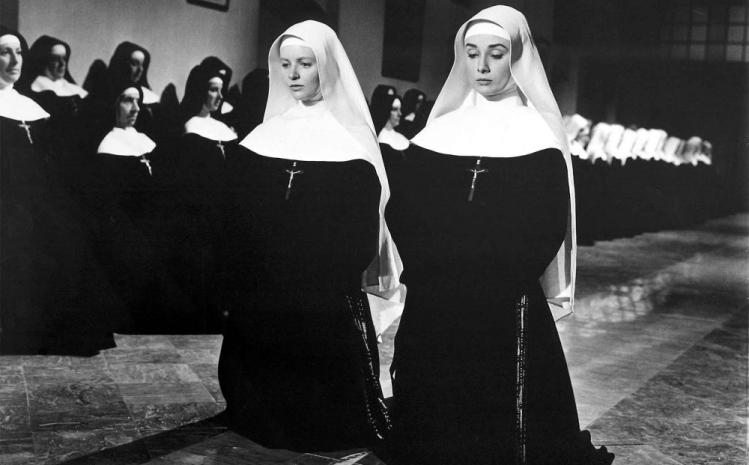
Flipping through the TV channels the other day—an annoying habit those of us of a certain age have—I came across the 1959 movie The Nun’s Story. I had of course heard of the movie. It famously features a luminous Audrey Hepburn in the Most Beautiful Movie Nun category, a prize long held by Ingrid Bergman. The film was an enormous success, raking in millions as well as eight Academy Award nominations, including one for Hepburn. No winners, however.
The film was directed by Fred Zinnemann, who won Best Director Oscars for High Noon, From Here to Eternity, and A Man for All Seasons, every conservative Catholic lawyer’s favorite film. Zinnemann, a Jewish immigrant from Austria whose parents were murdered in the Holocaust, seems to have had a feel for Catholic stories. Carl Theodor Dreyer’s The Passion of Joan of Arc was reputedly his favorite movie, and he shared with Dreyer a fondness for close-ups. I found The Nun’s Story fascinating in parts, if interminable. It traces the spiritual struggles of Gabrielle van der Mal, the brilliant and pious daughter of a Belgian surgeon, from the late 1920s to World War II. On one level, it almost plays like a recruitment film for the consecrated life. It is a very serious, if sometimes monotonous, examination of traditionalist Catholic spirituality. We follow “Gaby” from postulant, to novice, to final vows, then on to missionary work as a nurse in the Belgian Congo, and finally back to Belgium as war descends. The movie runs a penitential two and a half hours, which feels almost as long as it takes Hepburn’s character, no longer “Gaby” but now Sr. Luke, to come to the realization that she was not destined to be a nun after all.
Van der Mal joins a nursing, teaching, and missionary order based on the Sisters of Charity of Jesus and Mary, which was founded in the early nineteenth century in Ghent. The order is enclosed, and follows a strict rule. The film goes to great, almost documentary lengths in showing life under the rule in the convent (Zinnemann got his start in documentaries). There is a martial tone and a stark beauty to these scenes, amplified by the seemingly corpse-like obedience of the nuns, the dramatic rituals of their common prayer and life, and their elaborate rites of initiation. Nuns prostrate themselves before the order’s superior general, played with an unflappable and imperious authority by the great Edith Evans, whose voice has a certain monarchical timbre. Each nun conducts an examination of conscience twice daily, recording her faults in a notebook. Sins and failings are confessed before the superior general and the entire congregation. Nuns are required to call out the faults of other sisters—“in charity,” of course—in front of the entire congregation. (Luke Timothy Johnson has written about why this practice has wisely been discontinued in today’s monasteries—“How a Monk Learns Mercy,” October 5, 2018.) The superior general determines the appropriate penance. On one occasion, Van der Mal is instructed to kiss the feet of all the nuns in the refectory and beg them for bread. Penance is meted out if a drink of water is taken without permission between meals, if milk is spilt, if a nun talks to anyone without permission during “the great silence.” A series of hand gestures, rather than speech, is the convent’s workaday vernacular. In order to practice humility, the novices are instructed to walk close to the walls of the halls, never in the middle, and never to hurry. Their hands must stay still and out of sight, except when nursing or praying. Other nuns are never to be touched. You pull on someone’s sleeve to get her attention. Individual friendships are forbidden. All mail is read by superiors. Throughout the day, life is regulated by the convent’s bells, “which are the voice of God.” Even if nursing a patient, a nun must stop when the community is summoned by the bells.
The purpose of these seemingly trivial disciplines, as the film explains, is to instill obedience and humility: to place God’s commands, as they are made manifest by the order’s rule and hierarchy, before merely human desires or needs. Mirrors are forbidden. “Divest yourself of the vanities of this world,” the novices are told. They must detach themselves from family and friends, from material things, and even from memories of their previous life. In doing so, they make room for the love of Christ in their hearts. They are told that sacrifice is the only test of our love of God. Spiritual perfection is the ever-elusive goal, and it requires the most rigorous practices. The life of a nun, explains the superior general, is thereby one of endless sacrifice, and in many ways goes against human nature.
You can say that again.
What is remarkable about the film is its nuanced and sympathetic treatment of what many will consider to be some of Catholicism’s more extreme and bizarre teachings and practices. Sr. Luke’s ultimate decision to leave the order is not presented as a rejection of Catholicism or religious asceticism. The spiritual goods cultivated by the order are seen as valuable in themselves as well as instrumental in creating the sort of devotion and selflessness that enable the nuns to work with the desperately poor and chronically ill, and to endure the risks taken in establishing missions and hospitals in Africa. Sr. Luke wants to be this sort of person, this sort of nun, but struggles to reconcile the order’s demands for humility and obedience with the confidence and pride she takes in being a gifted student and exceptionally skilled nurse. She cannot submit to her superiors when what is demanded seems not only unreasonable but unjust. In one instance, she is asked to show humility by deliberately failing a university exam in order to bolster the confidence of a fellow sister (no, it doesn’t make sense). Unable to comply with this request, she is judged to be prideful, and subsequently given a less prestigious assignment as a discipline. She suppresses her “pride” again and again, only to have it resurface at crucial junctures. Her decision to leave the order is precipitated by the death of her father at the hands of the Nazis. She cannot forgive the killers, and that means she can no longer claim to be a bride of Christ, or possibly even a good Christian. She does not reject Christ’s teaching about loving our enemies, but simply realizes she is incapable of abiding by it. When she leaves the congregation she judges herself a failed nun, not a liberated woman.
The story behind the movie is equally interesting. It is based on the best-selling novel by Kathryn Hulme, which is the slightly fictionalized story of Marie Louise Habets, who spent seventeen years as a Sister of Charity of Jesus and Mary. Hulme and Habets met after the war when Hulme was working for a UN relief organization and Habets as a nurse tending to soldiers and refugees. At some point, Habets confessed that she was a “failed nun.” The two formed a bond and became inseparable, evidently living the rest of their lives as a couple in the United States. Hulme, raised Protestant and having been involved in a group of spiritual seekers surrounding a religious mystic in Paris before the war, converted to Catholicism in the early 1950s, presumably under Habets’s influence.
The website of the Sisters of Charity of Jesus and Mary suggests that the order no longer follows a rule as strict as the one Sr. Luke toils under in the movie. Much of the criticism of the Second Vatican Council, and now of Pope Francis’s interpretation of the council’s teachings, is based on the hope that it is possible to return in some way to many of the certainties and practices of the church depicted in The Nun’s Story (whose screenplay was evidently vetted and approved by the Vatican). However much one may appreciate the severe beauties and spiritual disciplines of the pre–Vatican II Church, one comes away from the film reminded of how far we are removed from that world. Watching the scene in the film where postulants enter the convent, leaving anxious family and loved ones behind, is like watching a contemporary movie depicting travel to another planet in a distant solar system. The convent’s door being closed with a heavy thud, and the mistress of postulants using her iron key to lock it, is like watching a rocket ship’s crew being hurled into deepest space. We are being taken on a voyage to another world, a world with a logic and beauty, but also dangers, uniquely its own.
The basic tension in Sr. Luke’s vocation is between the ambition and expertise she must possess to become a medical professional and the order’s demand that she understand herself to be “nothing” in order to draw closer to Christ. In an essay on the Seven Deadly Sins, Czesław Miłosz writes about the inescapable paradox inherent in the sin of pride, which he refers to using the Latin term superbia. “Pride and self-assurance are indispensable for the poet who wishes to achieve something and not retreat from his path,” he confesses. Its consequences, however, are of course “both negative and positive.” There can be no excellence if we don’t take pride in our work, but if pride becomes the principal motivation we have indeed lost our way. That balance was lacking in Sr. Luke’s formation, which mistakenly sought to expunge the self in pursuit of a higher good. As a consequence, her life and story can seem not only anachronistic but terribly misdirected. Yet we should not pretend the post–Vatican II Church has found a better balance in its often-unexamined celebrations of the self. We are still finding our way forward, and it is hubris to condescend to the past.
Please email comments to [email protected] and join the conversation on our Facebook page.
Previous Story
Poem | The Astronaut’s Body
Next Story
Time Is on Our Side


